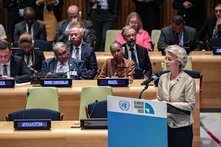Global climate policy is the subject of multiple announcements put to the test over the course of these two weeks of COP26. Between the countries that have established carbon neutrality targets for 2050 (the United States and the European Union) and those looking to 2060 or further instead (Russia, China, India), the major challenge lies not in the deadlines, but in the translation of these dramatic promises into concrete actions and in establishing transparent mechanisms for their implementation, leading to substantial reductions in emissions. International civil society is already putting pressure on the heads of state and government to achieve a “real zero” based on real change, to ensure that these neutrality targets are more than just covers for business-as-usual.

The years continue to pass since the start of the COP process and the negotiations likewise come and go. Negotiations on the climate lacking the necessary scope and, indeed, notable results follow on from each other without achieving anything of great significance. At the end of each summit, we gratefully receive a handful of decisions that probably help the negotiators of the wealthy countries to sleep at night but which unquestionably fall a long way short of the expectations of international civil society and the requirements of the highly specific current situation, in which the effects of climate change are a real threat, now more than ever.
This year, radical and bold solutions are anticipated, putting an end to false promises and giving climate diplomacy its noble purpose back. However, these decisions must not only guarantee the necessary transparency in the implementation of the targets, but also, and above all, bolster a sense of solidarity between the developed countries and the most affected countries and those considered most vulnerable. There can no longer be any doubt that the fight against climate change and its inevitable consequences requires efforts on a large scale, in other words a planetary scale, that are carefully orchestrated and supported by hard-hitting climate policies and methodical, coordinated climate action that is adequate to meet the challenge of climate change and with everybody pulling in the same direction.
In October 2021, the United Nations Development Programme (UNDP) shared its annual report on the state of play with the reduction in emissions of greenhouse gases (GHG) for 2021. The report, entitled “The Heat is On’’, concludes that the commitments made up to 2030 and the carbon neutrality pledges will put us on an emissions trajectory of 2.7°C by around 2100. This puts this figure below its 2019 equivalent, when the commitments were projected to take us to around 2.9°C by the end of this century. This result is therefore considered insufficient to remain below the 1.5°C defended by scientists and set out in the Paris Agreement (article 2). If we are to avoid disastrous climate consequences and remain below 1.5°C, the report stresses that global emissions must be halved in each of the next eight years. Readers may recall that we are already at an increase of around 1.2°C in average temperatures on Earth compared to the pre-industrial period.
It is therefore clear that we need to rethink our ambitions and show greater resolution to make COP26 a success. Everything must be designed with success in mind, which means that we need to highlight the need for solidarity and make sure that the commitments made are credible and realistic. Obviously, the largest economies of the world have a responsibility to steer climate action and to set an example to the other signatories of the UN Climate Convention. There are many legitimate questions concerning the engagement of the wealthiest countries.
In the second part of this article, I will present an overview of the recent positions announced by various emitting countries. These positions certainly influence the talks and will be seen as key statements by the other state parties to the Convention.
Russia
COP26 is going ahead without Russian President Vladimir Putin. The Kremlin gave no reasons for his absence, but took pains to stress that the climate dossier is still a priority for Russia.
Delaying the energy transition is no longer a viable option for Russia from an economic point of view, as Russian exports of metal and fossil fuels depend largely on a European Union that is in the process of converting to renewables and a low-carbon economy. Similarly, scientific figures put it beyond a doubt that parts of Russia are warming up at twice the speed of the global average. This goes some way to explaining the record forest fires in Siberia in June 2021 and the unprecedented heatwave that hit Moscow the same month (second link in French only).
Russia has already presented its target of carbon neutrality by around 2060, but it has drawn criticism for being based on the quality of carbon absorbed by forests rather than the necessary radical reductions in emissions.
The United States
Unsurprisingly, the current President Joe Biden has not missed the inauguration of this 26th climate summit and is accompanied by an extra-large delegation of high representatives, to demonstrate his government’s sensitivity to the climate cause. It is worth noting that Biden’s national climate programme, which states his intention of rapidly replacing national electricity power stations that run on coal and gas with wind energy, is at risk of being compromised due to the steadfast opposition of a Democrat senator who holds a key vote. Another noteworthy American figure in Glasgow is former President Barack Obama, who is attending COP26 in support of youth activists, according to the news agency Reuters.
The attendance of the second-largest emitter of GHG will reaffirm the American commitment to global climate policy in the wake of the term in office of Donald Trump, who completely benched the climate dossier. Along the same lines, the largest economy in the world is expected to encourage and motivate wealthy countries such as Australia, which are still hesitant, to adopt ambitious and robust plans.
Germany
On the other side of the Atlantic, the political parties negotiating a Traffic Light coalition in Germany will probably reiterate its promises to move away from coal, the principal source of energy in Germany. The members of the potential coalition have already announced that the end of coal will need to happen in around 2030 in order to green Europe’s largest economic powerhouse and limit its dependence on fossil fuels.
United Kingdom
As for the commitment of the host country, Prime Minister Boris Johnson has an ambitious carbon neutrality programme, which has been described by the British Committee on Climate Change as one of the most ambitious plans of the whole G20. Following several delays, this will certainly lend greater credibility to the country that will chair the summit. The Prime Minister nonetheless acknowledges the complexity of the task at hand and has made no secret of his great concern that COP26 will not deliver decisions that are commensurate with the challenge.
China
China will be one of the ones to watch at COP26, having sent out a clear signal to the international community in September, pledging to achieve peak emissions before 2030, with a view to carbon neutrality by 2060. The country is also expected to present updated emissions reduction targets shortly after COP26. The Chinese President Xi Jinping will not attend the meeting in person, but will take part remotely. China will therefore be represented in Glasgow by the Climate Envoy and Deputy Minister for the environment.
India
The world is still waiting for the third-largest emitter of GHG, India, to update its commitments, even though the deadline of 12 October set by the UNFCCC has been and gone. India may pledge to cut its carbon intensity by between 46% and 48%. Right after the start of the COP26, the Indian government announced a commitment to carbon neutrality by 2070.
Australia
Prime Minister Scott Morrison has announced his government’s plans for carbon neutrality by around 2050, without commenting on the country’s emissions reduction targets set in 2015. We can therefore assume from this that Australia is likely to be planning over the longer term, after several years of climate inaction, with no intervention at the level of its interim targets for 2030. Additionally, the new Australian climate plan has come in for scathing criticism, particularly from the opposition and the Labour Party, which describes it as a “scam”. The country-continent, which is considered a major player in fossil fuels because of its huge production and export of coal, takes last place (31st) on the list of efforts made by the rich countries in terms of reducing emissions and hiking up ambitions. All of this means that Australia may be a target for international pressure to increase its climate commitments.
The G20
In a letter to the member countries of the G20, the United Nations urged them to tighten up commitments that are considered less ambitious, particularly after the publication of the most recent assessment report of UNEP in August 2021, entitled “Code Red for Humanity”, arguing that immediate and drastic reductions in emissions are necessary. The United Nations also called upon the countries of the G20 to cease the financing of new fossil fuel-based projects.
With COP26 in full throttle, global climate policy is seeing an array of decisions and announcements. Between the countries that have established climate neutrality targets for 2050 (the United States and the European Union) and those looking to 2060 or further instead (Russia, China, India), the real challenge lies in translating these promises into concrete actions and in establishing transparent mechanisms for their implementation, that are enough to lead to substantial reductions in emissions.
With more of these announcements following every day, it is important to avoid making the mistake of overusing the principle of climate neutrality and denuding it of all meaning with greenwashing practices and false promises that will do nothing but delay action. This, in turn, will compromise the future and force the communities that have been the hardest hit by the effects of climate change to suffer even more unmanageable consequences of the climate crisis. International civil society is remaining calm and unflinching in the face of all attempts to side-track the debate on genuine climate action towards half-measures. Its mission is also to remain alert to any underhandedness on the part of the wealthy countries and the lobbies that may infiltrate the debates.
The talks are likely to be eventful and all scenarios are possible at this critical COP26.
This article was first published in French by the Heinrich-Böll-Stiftung Tunis office.


